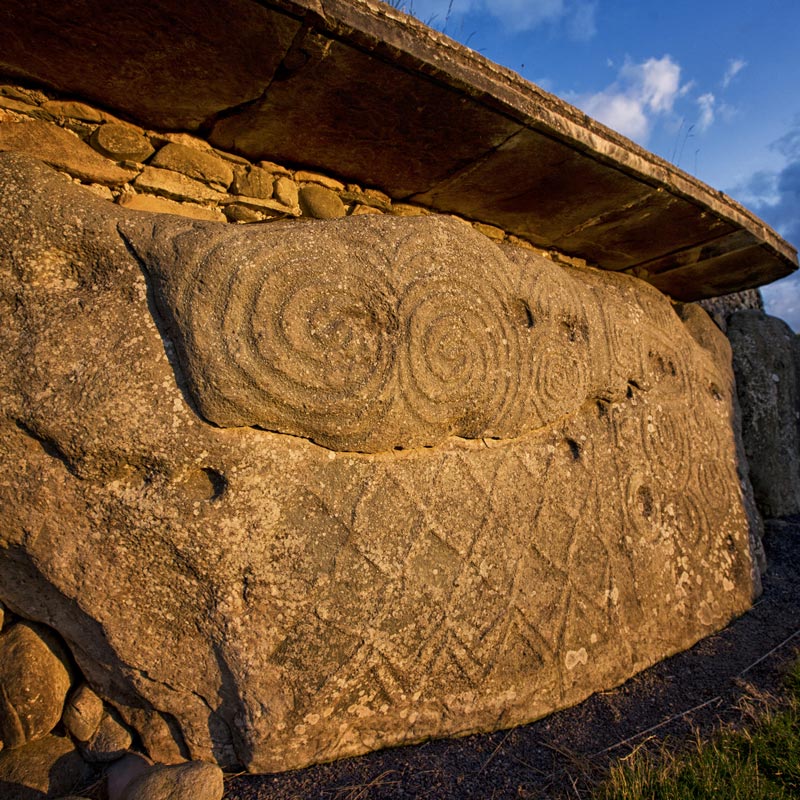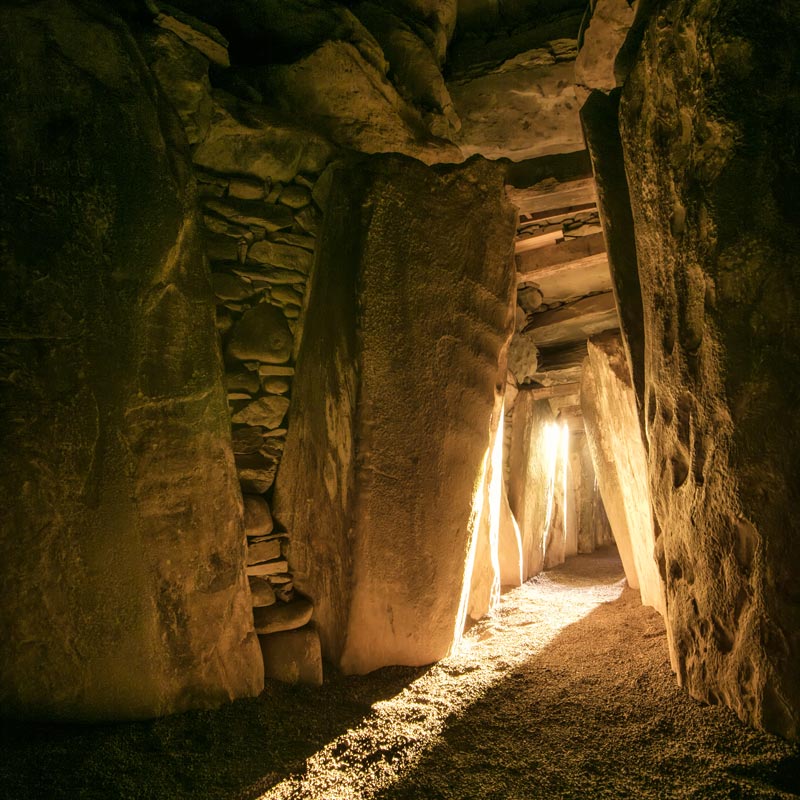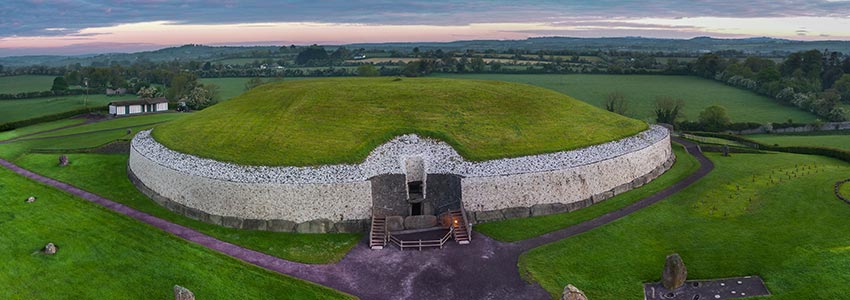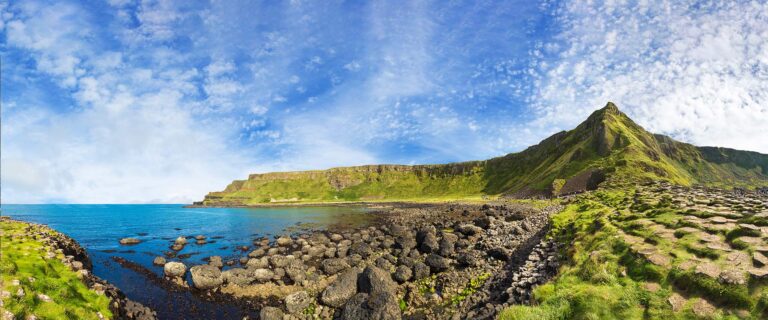Newgrange, just 26 miles outside of Dublin, is steeped in mystery and wonder. This remarkable site was left untouched until invaders found it in 1699. And, still, it was not excavated until the 1960’s. Archaeologists discovered that on the winter solstice, sun rays pour into the tomb and light up the ancient burial chamber. This remarkable display makes Newgrange the world’s oldest solar observatory. Here is what we know about it:
1. Newgrange is one of the best examples in Western Europe of the type of monument known as a passage-grave or passage-tomb
According to Carbon 14 dating techniques, Newgrange was constructed around 3200 BC. This means it is at least 600 years older than the Giza Pyramids in Egypt, and 1,000 years older Stonehenge. Amazing.
2. Newgrange is known as a brugh, or brú, which is occasionally translated as ‘mansion.’
But the old Irish word for ‘womb’ is Brú and so, Brú na Bóinne may be more correctly translated as ‘Womb of the Moon,’ or ‘Womb of the Bright Cow.’ Many researchers, archaeologists, and artists, plus your average adventurer, believe that the layout of the entrance, passage, and the chamber of Newgrange resembles the female life-giving organs.
3. Perfectly aligned with the Winter Solstice.
On the Winter Solstice, the light of the rising sun enters the roofbox of Newgrange and penetrates the passage, shining onto the floor of the inner chamber. The beam illuminates the inner chamber of Newgrange for just 17 mystical minutes.
4. Newgrange was built during an age when the only building materials were stone.
Everyday tools and weapons were also made of stone. According to Clare O’Kelly, who assisted her husband Michael O’Kelly while excavating Newgrange, no metal has been found as a primary building material in any Irish passage-grave.
5. Newgrange was rediscovered in 1699.
The landowner, Charles Campbell, needed some stones and asked his workers to carry some away from the cairn. When those stones were moved, the entrance to this extraordinary tomb was uncovered.
6. Newgrange sits on a long ridge, cradled by a bend of the Boyne River five miles west of Drogheda.
The entire area of the Boyne Valley has figured prominently throughout Irish history. According to legend, the foundations of Christianity were laid in the Boyne Valley. Oldbridge, two miles downstream from Newgrange, is where the Battle of the Boyne occurred in 1690.

7. Newgrange attracts almost 200,000 people each year.
This makes it the most visited archaeological monument in Ireland. (Plan to come early.)
8. Built for an Ancient Irish King.
According to ancient mythology, the Tuatha Dé Danann ruled Ireland and were said to have built Newgrange as a burial place for their chief, Dagda Mór, and his three sons. One of his sons, named Aonghus, is often referred to as Aonghus of the Brugh. It is believed that he was owner of the Brugh land, and that a smaller mound between Newgrange and the Boyne was owned by the Dagda.
9. Newgrange is said to be the place where the great mythical hero Cúchulainn was conceived by his mother Dechtine.
His spiritual father, Lugh, visited Dechtine in a dream while she stayed at the Brugh—Newgrange.
10. Linked to Swans & Stars.
There’s a romantic tale of Aonghus and Caer who flew to Newgrange, living there in the form of swans, and it can be linked to the stars. (This relates to both the ancient and present astronomical importance of Newgrange.) Interestingly, Newgrange is a wintering ground for the Whooper Swans which migrate from Iceland every October and return in March. It seems these early people combined natural science and mythology, and did so quite comfortably.
11. Newgrange is built with 200,000 tons of material.
It has been estimated that its construction would have taken 30 years using a workforce of approximately 300 people.
12. We don’t know how the larger stones, forming the kerb, passage, and chamber of Newgrange, were brought to the site.
Many of the 550 largest stones were collected from the ground they’d been lying on above the hills of Newgrange. Because many of the stones were weathered, we believe they weren’t quarried. That left those ancient people with the huge task of finding the stones that could best be moved, and to invent the means of moving them. These people lived in an exceptionally organized community.
13. These ancient builders were highly skilled.
They grooved the top surface of the passage-roof stones, thus showing they understood redirecting water seepage from the cairn. It has kept the passage water-proof—no small feat in Ireland. Some archaeologists believe the Newgrange site was as high as 150 feet in some areas. The passage, the chamber, and the roof were all constructed, and have survived, without mortar. The builders filled the gaps between roof stones in the passage with sea sand, and they burned soil to keep the passage dry.

14. All of the Newgrange satellite sites, the passage mounds, and standing stones in the area, originally had their own names.
They included ‘The Bed of Dagda,’ ‘The grave of Bóinn, the wife of Nechtain,’ ‘The Valley of Mata’(the giant monster), and ‘the Mound of Bones.’ Pure Poetry, and rich with stories now unknown and untold.
15. One of the most unusual satellite sites is located to the east of Newgrange and is a large U-shaped cursus.
This type of monument is believed to have served a rich ceremonial purpose. In recent years, archaeologists have discovered a ceremonial pathway that connected nearby passage-tombs to the cursus structure. What went on here?
16. Stones that function as a calendar.
Archaeo-astronomer Frank Prendergast has data which shows the Great Circle Stones were both astronomical and functioned as a calendar.
17. Accurate Roofbox and Sunbeam.
A 1972 survey of the roofbox, passage, and chamber of Newgrange, found that the Winter Solstice orientation of the site was an original feature, and that the sophisticated construction methods maximize the accuracy and length of the beam entering the chamber. A further study showed that, at the time of construction, the sunbeam was so accurately framed by the roofbox aperture that Newgrange could be used to determine the exact day of solstice.
18. The color of the sunrise inspired naming of ‘Red Mountain.’
It is believed by some researchers that the color of the sunrise on the morning of Winter Solstice was the original inspiration for the name of the hill over which that sunrise occurs when viewed from Newgrange. The hill is called Red Mountain. Venus also would have been visible inside the chamber of Newgrange at certain times during its eight-year cycle.
19. One interesting find in Newgrange is Roman coins.
The first recorded find of a Roman coin in Newgrange was in 1699. Coins were still being found in the 1960s when Newgrange was excavated. These included gold coins and pendants—some of them in mint condition.
20. Largest number of carved stones in Ireland.
Some very intricate, plus beautifully designed and carved, stones are in Newgrange, but many believe the art doesn’t match that of nearby Knowth in terms of overall numbers and grandeur. Four-fifths of these incredibly decorated passage mounds, both ceremonial and scientific in design, are located in County Meath, home of Newgrange. A vast majority of the stones uncovered by archaeologists are covered with megalithic art, including the triple spiral that has come to symbolize ancient Ireland herself. A very organized culture, indeed.
Discover the wonders of mystical Ireland with our 8-Night Ancient and Medieval Mysteries tour.










